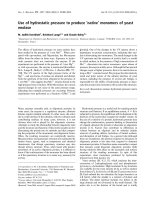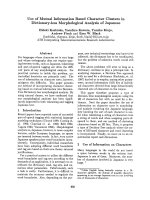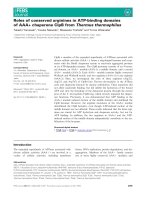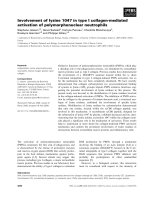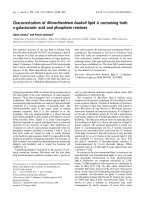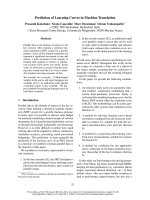Báo cáo khoa học: "Use of prophylactic fluconazole in a neonatal intensive care unit: efficacy is similar to that described in adult high-risk surgical patients" ppsx
Bạn đang xem bản rút gọn của tài liệu. Xem và tải ngay bản đầy đủ của tài liệu tại đây (30.77 KB, 1 trang )
Page 1 of 1
(page number not for citation purposes)
Available online />We read with great interest the recent article by Ho and
coworkers [1] concerning the use of prophylactic fluconazole
in high-risk surgical patients, in which those authors reported
on seven randomized controlled studies from the Cochrane
Controlled Trial Register. Ho and colleagues concluded that
the use of prophylactic fluconazole in immunocompetent
high-risk surgical patients is associated with a reduced
incidence of candidaemia, fewer patients requiring systemic
amphotericin B as rescue therapy for systemic fungal
infection, and no increase in the proportion of patients
colonized with or infected with fluconazole-resistant fungi, but
with only a trend toward a reduction in hospital mortality.
In addition to the high-risk surgical patients considered by Ho
and coworkers [1], preterm neonates in the neonatal
intensive care unit are at increased risk for fungal colonization
and infection but – despite positive reports from a limited
number of institutions including ours [2-4] – the use of
prophylactic fluconazole in these subsets is not yet viewed as
a standard of care [5]. Nevertheless, in our tertiary neonatal
intensive care unit we began to use fluconazole in 2001 in all
neonates with birth weight less than 1500 g, and our findings
are fully consistent with the data reported by Ho and
colleagues.
In particular, when we analyzed the decade from 1996 to
2005 and compared the period 2001–2005 with the 5-year
period before the introduction of fluconazole prophylaxis (388
versus 345 patients, respectively), we found significant
reductions in fungal colonization (any site: from 45.2% to
23.9%, 95% confidence interval 0.265–0.608; P < 0.0001),
fungal systemic infection (from 16.1% to 4.6%, 95%
confidence interval 0.135–0.498; P < 0.0001) and rates of
progression from colonization to infection (from 0.36 to 0.18,
95% confidence interval 0.148–0.802; P = 0.01), with no
increase in the number of infants colonized (10/345 versus
11/388; P = 0.45) or infected (5/345 versus 4/388; P =
0.35) by fluconazole-resistant fungi. Similarly to the findings
reported by Ho and coworkers, overall hospital mortality was
not significantly reduced with fluconazole (from 11.8% to
10.4%; P = 0.29); however, colonized infants treated with
prophylactic fluconazole were significantly more likely to
survive than were those who were not treated (mortality rate
4.1% versus 17.7%, 95% confidence interval 0.039–0.778;
P = 0.008).
Our data confirm the effectiveness of the strategy of
administering prophylactic fluconazole in a population of high-
risk patients other than those most frequently described (i.e.
high-risk surgical patients), and suggest that extension of this
policy to high-risk patients in neonatal intensive care settings
is warranted.
Competing interests
The author(s) declare that they have no competing interests.
References
1. Ho KM, Lipman J, Dobb GJ, Webb SAR: The use of prophylactic
fluconazole in immunocompetent high-risk surgical patients:
a meta-analysis. Crit Care 2005, 9:R710-R717.
2. Kaufman D, Boyle R, Hazen KC, Patrie JT, Robinson M, Donowitz
LG: Fluconazole prophylaxis against fungal colonization and
infection in preterm infants. N Engl J Med 2001, 345:1660-
1666.
3. Kicklighter SD, Springer SC, Cox T, Hulsey TC, Turner RB: Flu-
conazole for prophylaxis against candidal rectal colonization
in the very low birth weight infant. Paediatrics 2001, 107:293-
298.
4. Manzoni P, Arisio R, Mostert M, Leonessa M, Farina D, Latino MA,
Gomirato G: Prophylactic Fluconazole Is Effective in Prevent-
ing Fungal Colonization and Fungal Systemic Infections in
Preterm Neonates: A Single-Center, 6-Year, Retrospective
Cohort Study. Pediatrics 2005, Dec 1 [Epub ahead of print].
5. Long SS, Stevenson DK: Reducing Candida infections during
neonatal intensive care: management choices, infection
control, and fluconazole prophylaxis. J Pediatr 2005, 147:135-
141.
Letter
Use of prophylactic fluconazole in a neonatal intensive care unit:
efficacy is similar to that described in adult high-risk surgical
patients
Paolo Manzoni, Daniele Farina, MariaLisa Leonessa, Claudio Priolo and Giovanna Gomirato
Neonatology and Hospital NICU, Azienda Ospedaliera Regina Margherita, Turin, Italy
Corresponding author: Paolo Manzoni,
Published: 5 January 2006 Critical Care 2006, 10:402 (doi:10.1186/cc3958)
This article is online at />© 2006 BioMed Central Ltd
See related research by Ho et al. in issue 9.6 [ />



